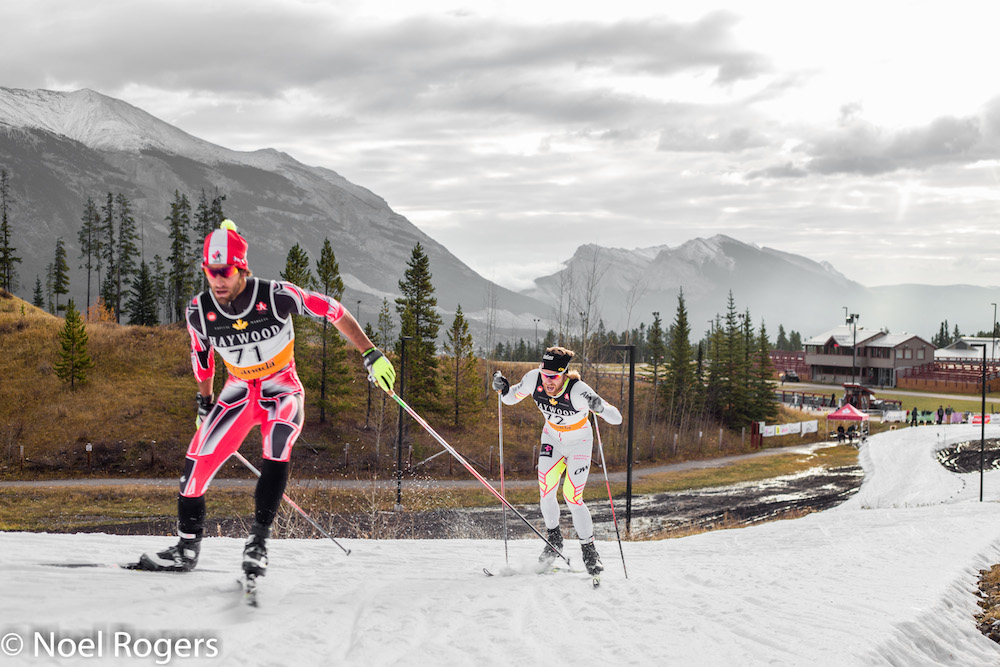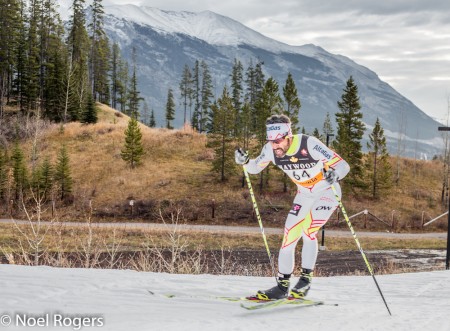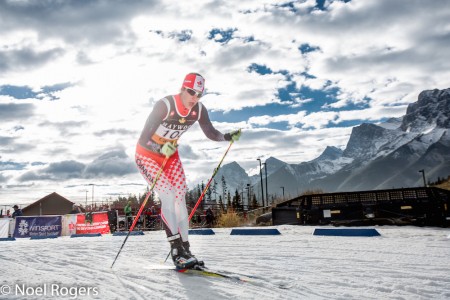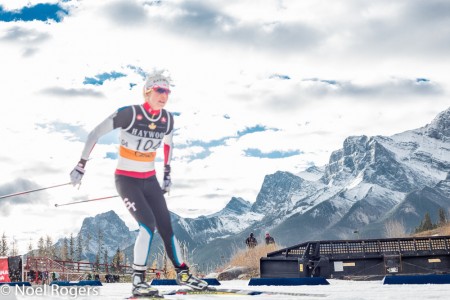
A 1.8-kilometer loop can get crowded with 101 racers, especially when each competitor is racing anywhere from four to six laps.
Such was the case at Monday’s Frozen Thunder freestyle-individual start in Camore, Alberta. Jumping at the chance for on-snow training and racing in October, groups including the U.S. Ski Team and Canadian national cross-country and biathlon teams converged on the Canmore Nordic Centre.
In the men’s 10.8 k race, the good ol’ boys of North American nordic skiing came out on top.
Devon Kershaw of the Canadian World Cup Team skied his way to a win in the freestyle-interval start in Canmore, Alberta, with a time of 23:00.4.

Not far behind was U.S. veteran skier Kris Freeman (+5.1) of Team Freebird. After three laps, Freeman was roughly 13 seconds behind Kershaw but gradually erased the deficit as the finish inched closer.
Freeman’s final surge was not enough to overcome Kershaw, who clocked the fastest time in each of the first three laps.
Kershaw said that the crowded 1.8 k loop did little to distract him from his race. Comparing the conditions of the loop made of saved-snow to several past World Cups, Kershaw said that the busy Frozen Thunder track was nothing he hadn’t seen before.
“You just move around people that are slower than you and it’s actually pretty easy to not focus on that aspect of it. A busy track doesn’t bother me when I’m racing,” Kershaw wrote after his win.
Freeman agreed, writing that in the modern era of nordic skiing, short loops have become more abundant – even in the winter season. He said that while he was careful when overtaking his competitors, everyone he met on the course gave enough space for a fellow skier to pass.
Kershaw said that since its conception, Frozen Thunder has continued to get bigger and better. This year was no different.
“The Frozen Thunder races are getting more and more popular as the years go on,” he wrote. “The volunteers here in the Bow Valley that make events like this happen are just so incredible. When you’ve got athletes from the U.S. coming up, and training centres and clubs from across the country coming to compete and train here – it shows just how fantastic a success and how well received the whole Frozen Thunder project is.”
Third place was claimed by Biathlon Canada’s Scott Perras, who finished 30.8 seconds behind Kershaw.
For Perras, the race was an opportunity to ski with the Canada’s cross-country team. He said that Canadian biathletes and and cross-country skiers rarely interact due to the diverse schedules of each team.
“It was great to get to ski parts of a race with Kershaw,” he wrote. “I’ve never actually been in a cross country race when he was around. October really is the only time of year cross country and biathlon get to have some fun chasing each other.”
Perras and teammate Brendan Green wore one of each other’s skis so that they could compare their results without worrying about variation in ski speed. He was able inch past Green who finished 1.3 seconds behind. Perras said the laps he spent skiing with Kershaw made the all the difference.
Perras also noted that the top three men in Monday’s race were some of the oldest in the field of 64.
“As an ‘old guy’ this brings a smile to my face,” the 31 year old said. Kershaw is also 31 and Freeman is 34.
Further down the results sheet was Simi Hamilton of the U.S. Ski Team (USST). While the Stratton Mountain School (SMS) T2 skier finished 40th and roughly three minutes and 20 seconds behind Kershaw, his result is misleading. Hamilton recently suffered “a mild shoulder tweak” and skied the entire race with one pole.

In the women’s 7.2 k race, Rosanna Crawford (Biathlon Canada) bested a strong women’s field to take the win. After four laps around the Frozen Thunder track, she finished with a time of 17:39.2.
Despite soft conditions, Crawford explained she felt strong throughout the race and enjoyed starting near the back of the pack.
“Starting near the end meant there was a lot of girls I could chase down. I love having someone just within sight that I can try to chase down and pass!” she wrote in an email.
Crawford, who just completed a two-week block of treadmill rollerski intensity, explained that the race helped her begin the transition from dryland training to on-snow racing.
Coming in second for the women was USST member Liz Stephen (+3.6), who traditionally excels on hilly courses with long climbs. Monday’s race had no such climbs and was relatively flat.
Taking the final spot on the podium was Canadian biathlete Zina Kocher (+11.7). Kocher said that while she also favors hill-intensive courses, the Frozen Thunder distance race left her feeling technically and physically strong going into the final weeks of fall training.
Now that Frozen Thunder racing has concluded, the North American teams will part ways before they begin their final training blocks of the fall. The Canadian Biathlon Team will host a time-trail on the 1.8 k ski loop Friday, as part of their continued training camp.

Results:
Lander Karath
Lander Karath is FasterSkier's Associate Editor from Bozeman, Montana and a Bridger Ski Foundation alumnus. Between his studies at Middlebury College in Vermont, he is an outdoor enthusiast and a political junkie.



